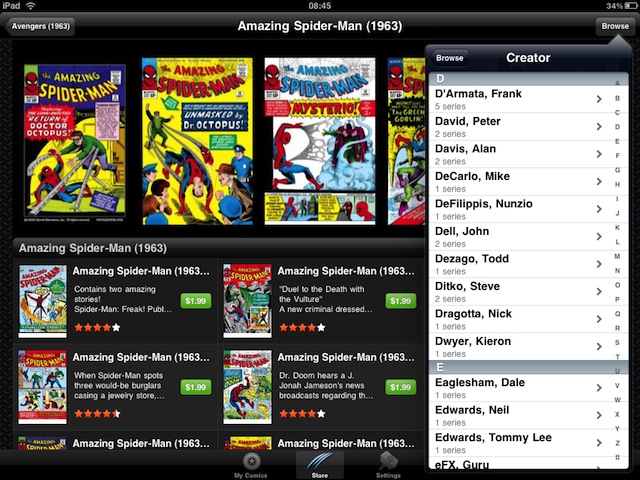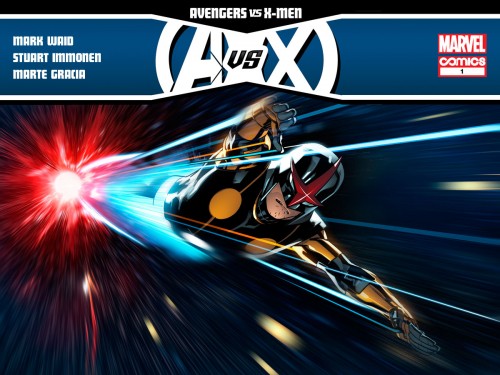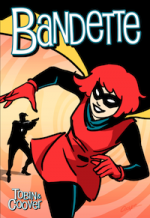The Complete Guide to Digital Comics (Part 1) How the iPad changed digital comics and the growth of ComiXology
 Digital comics are fast becoming as vital and exciting a part of the world of comics as traditional newsstand ‘floppies’. Taking up an estimated 15% of the comic market share in 2013 (according to both Image Comics and 2000ad) digital comics are taking over! At the heart of this digital revolution is the iPad and the undisputed king of digital comics apps, ComiXology’s Comics, we take a look at how these two came to dominate the digital comics landscape in the first part of our Complete Guide to Digital Comics.
Digital comics are fast becoming as vital and exciting a part of the world of comics as traditional newsstand ‘floppies’. Taking up an estimated 15% of the comic market share in 2013 (according to both Image Comics and 2000ad) digital comics are taking over! At the heart of this digital revolution is the iPad and the undisputed king of digital comics apps, ComiXology’s Comics, we take a look at how these two came to dominate the digital comics landscape in the first part of our Complete Guide to Digital Comics.
How the iPad launched the digital comics revolution
Although digital comics existed before the iPad (in the form of web comics and digital downloads of PDF and CBZ and CBR files) they weren’t actively supported by major publishers like Marvel and DC. So despite often being DRM free – meaning they were easily shared – it also meant they were easily pirated and the number of top titles weren’t there, making digital comics very much a niche product.
With the launch of the iPad in April 2010 everything changed for digital comics. Not only was Apple’s new 7.9 inch tablet the perfect medium for reading comics on, but thanks to the Marvel Comics app being part of the launch suite of app, the world’s biggest library of classic comics was now available at the tap of a screen, bringing digital comics to the mass market. As the iPad sales flourished so did the sale and growth of digital comics.

The company to succeed most out of this rise was ComiXology, creators of the top-grossing Comics app for iPad. Founded by David Steinberger, John Roberts, and Peter Jaffe ComiXology had a thriving online prescence as a web-based comics platform, but with the launch of the iPad came a whole new market for them to expand into. Initially this was in the role of software provider as the creators of the code behind the Marvel Comics app (as well as a host of others including Image, IDW Publishing and more.)
ComiXology’s Comics app and it’s siblings, offered fans a familliar storefront structure to buy and browse titles, along with a wealth of great titles from major publishers. In the early days this even included a DC Comics storefront within the Comics app! Although the number of titles available at the launch of the respective apps was not comprehensive, in time this would begin to change with more and more titles becoming available in increasingly better quality (keeping up with the iPad’s development ComiXology launched ComiXology HD to match the iPad’s new retina screen). Titles would soon become available at the same time as the printed predecessors – known in the trade as day and date publishing – offering fans a viable alternative to heading to the comic books tore every week, instead they could just download them onto their iPad. (And as of July 2009, to their iPhone too!)
Although other apps were available, such as iVerse’s Comics Plus, Panelfly and Graphicly, which offered a greater range of independent titles, not available on ComiXology at that time, it was Comics that would be come to dominate the market. Thanks to their huge library of titles that has continued to grow and grow, they have become one of the iPad’s top grossing apps of all time (regularly appearing in Apple’s Top 10 lists) and as ComiXology’s success has grown it has also allowed readers to synch titles across their iPad, iPhone and desktop PCs as well as now offering compatability with Google and Amazon tablets.
Read our guide to the top 5 digital comics apps for the iPad
How Guided View changed the landscape of digital comics
As well as the huge collection of titles available, one key area which allowed ComiXology to flourish was their patented Guided View technology for reading comics. Allowing fans to browse through comics at the tap of the screen as well as zooming in to read panel-by-panel, it means the reading experience is completely unlike reading a print title as readers can take in the story element by element getting even more involved with every moment.
Comic artists and writers have been quick to embrace this functionality as a new way to tell stories blurring the lines between comics and animation. Thanks to Guided View artwork can appear on screen in sequence rather than all at once on the page allowing the creators to guide their reader through the story at a different pace and with a more active experience making stories much more exciting. Some great early examples of creators trying this out include Alex de Campi’s Valentine and Kurt Christenson and Reilly Brown’s Powerplay, both of which helped to really set the stage for what was to come.

It was not long before the big names started seeing the potential of this new medium and in the summer of 2012 Marvel Comics unveiled their Infinite series of digital comics with Avengers vs X-Men: Nova. A tie-in to that years epic Avengers vs. X-Men crossover, this prequel to the series was low on dialogue but high on action, and showed off the true potential for the medium with sweeping intergalactic vistas and planet shaking action courtesy of artist Stuart Immonen. Marvel would continue producing one-off Infinite titles in 2012 and in 2013 they introduced their first ongoing series Wolverine: Japan’s Most Wanted.
Keen to get in on the action DC Comics subsequently released their own version of an ‘Infinite’ comic with Batman ’66 under their DC2 Interactive banner while ComiXology have in turn created their own genre of comics known as ‘Guided View Native’ which sees indie talents create amazing titles like Matthew Petz’s War of the Woods and Quinton Miles’ Template sit alongside the big boys from Marvel and DC, creating this unique brand of digital comic.
The godfathers of digital comics

When it comes to the development of mainstream comics there are two names who stand head and shoulder above the rest. The most high profile is Daredevil and Flash writer Mark Waid, who was the man behind the script of those first Infinite books. Waid had begun to develop his own experimental series of digital comics via his website Thrillbent, which began with the simple zombie series Luther and developed into his own series Insufferable with artist Peter Krause. He would go on to champion exciting new titles like Moth City and The Eighth Seal as well as working on high profile titles like Avengers vs. X-Men. His name value would help bring attention to digital comics and many of these titles would come to define the template for digital comics. However he could not have done it without with the assistance of layout artist Yves ‘Balak’ Bigerel.
The unsung hero of digital comics, Balak posted a short article on DeviantART in 2009 entitled ‘About Digital Comics’ which showcased the early potential for a hybrid of animation and comics that laid the ground work for the digital revolution. Balak has since helped Waid and co. create the ground work with Thrillbent and Marvel Infinite with ideas which are now common place ideas such as pull focuses, long sweeping panoramas and the sequential use of text. Preferring to keep a lower profile than Waid, Balak is every bit as important to the development of digital comics as his more high profile patron and is a true pioneer of digital comics!
Read our interview with Mark Waid discussing Infinite comics & Thrillbent
The wonderful world of MonkeyBrains and ComiXology Submit
By opening up the market to new creators to release titles we have seen a whole host of new digital-first publishers appear producing superb books which otherwise might not have seen the light of day. Even ComiXology themselves have dabbled with being a digital publisher releasing titles like David Gallaher and Steve Ellis’ Box 13 a title that was subsidised by ComiXology and became one of the first digital-first publications.

Other digital-first publishers would follow, most notably MonkeyBrain Comics who were launched in July 2012 by Chris Roberson and Allison Baker. Their debut featured 5 fantastically different titles from post-modern superhero Edison Rex, to all ages adventure Amelia Cole alongside sublime hand drawn fairytale Aesop’s Ark. Subsequently MonkeyBrain have developed a unique niche as the home of innovative and award-winning titles such as Masks and Mobsters (NY Times Comic of the Year 2012) and the Eisner award winning Bandette, as well as producing sublime one-shots like Kurt Busiek’s Thoughts on a Winter Morning. With many titles offered for the bargain price of £0.69/$0.99 it has allowed them to flourish without having to rely on a printing or distribution deal, so much so that many of these titles have since been released in print, reversing the traditional model for publishing.
With the boom in self publishing bringing more and more titles to the market, ComiXology helped aid this in 2013 with the advent of ComiXology Submit which allowed creators to easily upload titles to ComiXology and have them fitted to their Guided View format. Bringing a whole raft of new creator owned titles to the market place along with small scale offering from big name creators such as Becky Cloonan’s Demeter or Joshua Hale Fialkov’s The Bunker.
Read our interview with MonkeyBrain Comics founder Chris Roberson here!
ComiXology have helped to create a truly global market place for digital comics fans, but not everyone has embraced it. In the next instalment of our Complete Guide to Digital Comics we’ll look at those publishers who have used the iPad to create their own publishing platforms.
December 17, 2013 @ 6:06 pm
You’re so awesome! I don’t suppose I have read a single thing like
that before. So wonderful to find somebody with some unique thoughts on this
subject. Seriously.. thank you for starting this up.
This site is one thing that is required on the
web, someone with a bit of originality!
July 15, 2025 @ 6:17 am
Just want to say your article is as amazing.
The clearness to your publish is simply cool and that i can assume you’re knowledgeable on this subject.
Fine along with your permission allow me to clutch your RSS feed to stay
up to date with forthcoming post. Thank you one million and please continue the enjoyable work.
July 17, 2025 @ 2:41 am
Hello, just wanted to say, I loved this article.
It was funny. Keep on posting!
July 27, 2025 @ 4:17 pm
Nice blog here! Also your website loads up very fast!
What host are you using? Can I get your affiliate
link to your host? I wish my website loaded up as quickly
as yours lol
November 26, 2025 @ 1:41 am
Rimedi naturali contro l’artrosi – Hondrolife per dolore articolare istruzioni è il migliore.
Composizione pulita. Recensioni positive
November 26, 2025 @ 3:31 am
https://vk.com/public211532114
November 26, 2025 @ 5:47 pm
Йога дала мне ощущение внутреннего спокойствия
https://storeprofit.ru/
November 27, 2025 @ 10:13 am
а есть ли советы по доставке мебели?
https://777cargo.ru/
November 29, 2025 @ 6:07 pm
My puzzle skills are the one thing I’m genuinely proud of
jigsaw puzzle
November 29, 2025 @ 11:37 pm
Казино Чемпион Мобильная Версия Но будьте внимательны и читайте всю
прилагающуюся информацию, дабы не
быть обманутым. И самое главное контролировать свои эмоции и азарт,
иначе всё это может плохо для вас закончиться.
Аккаунт создал за несколько минут
и сразу решил пройти идентификацию,
чтоб не тратить на это время при обналичке.
Однако при этом у них есть
свои авторские особенности и незабываемые
черты. Благодаря этому страницы клуба не виснут, оперативно грузятся и быстро обновляются.
Бонусы, акции, призы и другие подарки от
администрации ждут как новичков,
так и опытных игроков казино.
Для вип-клиентов предусмотрены индивидуальные скидки и
предложения. Онлайн казино Чемпион поставило высокую
планку конкурентам на рынке азартного онлайн досуга.
Казино оставляет за собой право обрабатывать заявки на вывод в сроки от
5 до 10 банковских дней, в зависимости от суммы платежа. Помимо игровых
автоматов, на сайте Первого Казино присутствуют настольные
игры, в которые можно сыграть в компании с профессиональным живым крупье.
Данный раздел открывается только после регистрации на сайте и пополнения счета.
Казино Чемпион предлагает пользователям мобильную версию площадки,
которая позволяет получить доступ ко всему контенту, независимо
от наличия персонального компьютера.
Пользователям достаточно перейти на официальный сайт онлайн-клуба, используя
любой удобный браузер смартфона или планшета.
Украинское онлайн казино Чемпион — популярная
платформа, которая не теряет востребованности среди азартных игроков.
Заведение предлагает широкий ассортимент
игрового зала, доступ к лучшим аппаратам современности и щедрым выигрышам. Казино Elslots предлагает ряд удивительных игр,
в том числе лучшие высокотехнологичные слоты, доступные сегодня
в индустрии. Игроки могут воспользоваться ручным
и автоматическим режимом вращения барабанов.
Хозяева мобильных гаджетов получат шанс насладиться действом в аппаратах
при помощи мобильных устройств.
Я чacтeнькo кaтaю бapaбaны co
cмapтфoнa, тaк кaк мнoгo пpoвoжу вpeмeни в дopoгe.
Все контакты на сайте защищены современными алгоритмами шифрования.
Пополнить счет могут только лица, прошедшие регистрацию на платформе.
Все переводы могут осуществляться только с реквизитов и на счет участника.
Финансовые операции рекомендуется проводить в одной и той же валюте, чтобы
не возникла потребность в дополнительной верификации личности.
Так, Приват 24 и Qiwi работают с гривнами,
Webmoney выплачивает средства в любой
валюте клуба, Mastercard и Visa производят
выплаты в валюте, которой были введены
средства. Это прекрасная возможность делать ставки, получать вознаграждения и
всегда быть на связи. Оптимизированная
версия позволяет посетителям иметь доступ ко
всем поощрениям казино. Гости смогут получать бонусы, поощрения и проводить отыгрыши.
Стать постоянным клиентом онлайн-заведения Джокер со всеми привилегиями клуба могут участники,
которым исполнился 21 год.
my web site; atom автоматы официальный сайт
November 30, 2025 @ 2:56 pm
Заказывал на большую семью, минивэн
был идеален
https://botdb.win/wiki/Taxi-minvodi_46Z
December 1, 2025 @ 12:21 am
Консультация бесплатная, а врач
говорил со мной час, всё подробно
http://wiki.thedragons.cloud/index.php?title=User:KandyBedggood
December 5, 2025 @ 1:54 am
Привёл троих друзей по рефке — получил по 15к бонусов
каждому. Вывод на крипту
вообще мгновенный. Это лучшее казино, в которое я когда-либо играл!
драгон мани зеркало
December 5, 2025 @ 2:37 am
Умные светильники в коридоре
— включаются мягко, глаза не режет ночью.
my website – https://pakstore.ru/
December 5, 2025 @ 5:13 am
Жареный рис с курицей — классика,
которая никогда не надоедает, особенно
с соевым соусом
Вкусные суши
December 5, 2025 @ 1:59 pm
Бригада: фотоотчеты. Контроль.
Here is my web blog … https://kotelinaya.ru/
December 8, 2025 @ 9:41 pm
Dragon money официальный — и никаких подделок
December 9, 2025 @ 2:21 am
Бонус на серию ставок, если часто играешь
https://antenaqqslot.com/melbet-obzor-2025/
December 9, 2025 @ 2:38 pm
Наконец-то кто-то честно написал
про коэффициенты 96,5% на футбол, реально выше рынка
https://allo-offer.com/registratsiya-melbet-ofitsialnyy-sayt-2025/
December 10, 2025 @ 4:04 am
Есть раздел с конструктором ставок, прикольная штука
https://may.menuqtr.com/skachat-zerkalo-melbet/
December 11, 2025 @ 11:46 am
Ни разу не сталкивался с
обманом, всё честно.
My homepage … казино сол вход
December 11, 2025 @ 4:03 pm
Понравилось качество живых игр:
профессиональные дилеры, приятная атмосфера, никаких технических сбоев.
Всё на высоком уровне
1го казино зеркало
December 14, 2025 @ 1:11 pm
Драгон Мани отзывы подтверждают надежность платформы
My blog: dragon money обзор
December 14, 2025 @ 10:07 pm
Платежные методы в Риобет удобные, пополнение проходит моментально
My web site … riobet casino
December 15, 2025 @ 2:20 pm
Игроки ценят Dragon Money за стабильность и
скорость
драгон казино официальный сайт
December 17, 2025 @ 12:13 am
Monro casino промокод помог получить дополнительный бонус при регистрации
Feel free to surf to my webpage – monro казино
December 17, 2025 @ 12:17 am
В drip казино вход доступен круглосуточно
Stop by my web site … дрип казино зеркало
December 17, 2025 @ 2:51 pm
Dragon Money можно рекомендовать как надёжное онлайн-казино
Take a look at my site dragon money studio
December 17, 2025 @ 11:00 pm
Нормальный обзор без агрессивной рекламы
Have a look at my webpage: мелстрой онлайн
December 18, 2025 @ 5:21 pm
Забрали духовку бесплатно
My homepage Вывоз холодильников в Москве
December 18, 2025 @ 5:21 pm
За телевизор дали хорошую цену
Feel free to surf to my site; Утилизация стиральных машин в Москве
December 18, 2025 @ 5:32 pm
Рекомендую всем, кто хочет избавиться от
хлама
My web-site; Вывоз холодильников в Москве
December 18, 2025 @ 5:38 pm
Ребята вежливые, все сделали за полчаса
Feel free to visit my page: Вывоз стиральных машин
December 19, 2025 @ 10:57 pm
Wenn Sie einen Abend mit einer Show verbringen möchten, können Sie das hoteleigene Casino besuchen. Zu den weiteren beliebten Unterhaltungsmöglichkeiten gehören Comedy-Shows und
Duell-Klaviershows. Das Hotel bietet zudem einen 24-Stunden-Service.
Das Paris Las Vegas bietet eine Vielzahl von Annehmlichkeiten, um
jeden Aufenthalt unvergesslich zu machen.
Trotz dieser Verkleinerung bietet die Nachstellung in Las Vegas den höchsten Aussichtspunkt des Las Vegas Strips.
Diese Bar mit Dachterasse bietet tagsüber Schatten vor der Sonne
und bei kälteren Temperaturen Heizgeräte.
Sie sehen etwas altmodisch aus, obwohl die Suiten Whirlpool-Badewannen bieten .
Die Badezimmer sind mit Marmorwaschtischen, separaten Duschen und Badewannen,
Schönheitsspiegeln und Haartrocknern ausgestattet. Kostenlose Ortsgespräche und WLAN sind in der obligatorischen Resortgebühr der Unterkunft enthalten. Zu den Standardeinrichtungen in allen Zimmern gehören ein Flachbild-TV mit Kabelkanälen, ein Mini-Kühlschrank , ein Bügeleisen / -brett , ein Kofferständer und ein Safe .
Die Böden sind mit grauen Vierpassmustern ausgelegt und die Badezimmer sind mit Marmor ausgekleidet.
Zu den weiteren Annehmlichkeiten gehören ein Spa , ein Fitnessraum , kostenfreies WLAN und Parkplätze (gegen Gebühr).
Der riesige Pool hat eine entspannte Atmosphäre und Unterhaltung beinhaltet Feuer und Zirkus-Shows.
Außerdem sind rollstuhlgerechte Zimmer mit barrierefreiem
Badezimmer buchbar. Ein Fitnessstudio ist im Innenbereich
für Sportfreunde gebührenpflichtig. Auf der Sonnenterrasse mit Liegestühlen und Schirmen lässt
sich der Urlaub genießen. Das Hotel verfügt über rollstuhlgerechte Einrichtungen. Das Haus verfügt über eine Reihe von behindertengerechten Annehmlichkeiten.
References:
https://online-spielhallen.de/ice-casino-bonus-code-ihre-eintrittskarte-zu-fantastischen-angeboten/
December 20, 2025 @ 6:27 am
Бонус за регистрацию щедрый, 100% на первый депозит плюс фриспины.
my web blog – https://cpcturismo.com.br/melbet-2025-obzor-bk-partscore/
December 20, 2025 @ 6:39 am
Отзывы свежие всегда читаю.
Here is my web-site: http://donwarlick.com/melbet-2025-obzor-www-1000001-ru/
December 20, 2025 @ 6:46 am
Мобильная версия Мелбет летает на старом телефоне.
Не ожидал.
My web-site … https://pqmpavers.com/melbet-rabochee-zerkalo-2025/
December 20, 2025 @ 6:57 am
Вход по биометрии в приложении — удобно.
my web page :: https://larepublicana.com.ar/2025/11/02/zer-kalo-melbet-aktualnoe-segodnya-2025/
December 20, 2025 @ 6:59 am
Депозит криптой принимают, мгновенно
и анонимно.
My web site :: https://studiomonq.com/2025/11/02/melbet-obzor-2025-2/
December 20, 2025 @ 7:03 am
Мелбет приложение на телефон поставил — теперь играю везде.
Всё быстро грузится, без
тормозов.
my page https://biodescodificacion.ar/melbet-2025-obzor-bukmekera/
December 20, 2025 @ 7:15 am
Зеркало Мелбет всегда работает, даже
когда основной сайт подвисает.
Удобно.
Also visit my web page :: https://ollo999.net/melbet-obzor-2025/
December 20, 2025 @ 7:18 am
Бездепозитный бонус за отзыв.
Have a look at my site; https://gem69.com/melbet-zerkalo-oficialnyj-sajt-2025/
December 20, 2025 @ 7:41 am
Игровые автоматы с высокой отдачей, чувствую разницу с другими сайтами.
Check out my site – https://www.sledgehealth.com/melbet-oficialnyj-obzor-2025-igroki/
December 20, 2025 @ 7:49 am
Зеркало автоматом в приложении.
Here is my web-site https://esteticafelix.it/obzor-sayta-melbet-2025/
December 20, 2025 @ 8:07 am
Бонус за приглашение друга — обоим дают.
Also visit my site – https://www.adaicbio.com/2025/11/02/melbet-obzor-bk-2025/
December 20, 2025 @ 8:13 am
Вывод средств на карту без комиссии — приятно.
My blog: https://www.riverwedco.com.au/2025/11/02/melbet-zerkalo-rabochee-na-segodnya-2025/
December 20, 2025 @ 8:46 am
Турниры по провайдерам.
Feel free to visit my website https://new.bodysmarthealth.com.au/melbet-2025-obzor-bukmekera-2/
December 20, 2025 @ 8:53 am
Вход один клик после сохранения.
My blog … https://www.decostonepanel.com/blog/2025/11/01/slot-dog-house-megaways-melbet-2025/
December 20, 2025 @ 8:58 am
Фриспины без вейджера
иногда дают.
Feel free to visit my page: https://autorulategermania.ro/melbet-obzor-bukmekera-2025-2/
December 20, 2025 @ 9:18 am
Мелбет онлайн казино — мой фаворит.
Живые дилеры классные, рулетка
как в настоящем казино.
My web-site :: https://www.confortsp.com/melbet-2025-obzor-say-one-ru/
December 20, 2025 @ 9:44 am
Онлайн казино с быстрым выводом — редкость.
my website … https://topslot89.net/melbet-2025-obzor-bukmekera-2/
December 20, 2025 @ 9:17 pm
Фриспины ежедневно за вход.
My site – https://laalcanciasb.com/2025/11/01/dog-house-megaways-slot-melbet-2025/
December 20, 2025 @ 9:31 pm
Рулетка лайтнинг с множителями — адреналин.
Feel free to surf to my web page … https://bizcase.net/melbet-2025-obzor-bukmekera/
December 26, 2025 @ 12:50 pm
VPN легко настраивается
My web site :: впн бесплатный для инстаграм
December 26, 2025 @ 5:54 pm
You’ll need to wage bonus moolah 40 times to take it out.
Obtain twice as much free cash on your second deposit.
To withdraw bonus funding, wage it forty times. Plus, bookies
draw 100 Rocket Play casino free chips! Store real money for
the first time to grasp a great casino new customer offer!
Just like the first offer, the maximum bonus here is $A1,000 with a max bet of $A5.
The biggest issue for me was the lack of published RTP rates – I
couldn’t find clear information about return percentages for specific games.
The mobile experience deserves a mention – I tested several games on my phone and they all ran smoothly without any loading issues.
Alongside household names like Play’n GO and Yggdrasil, I found games from smaller studios like Spribe and Fantasma.
References:
https://blackcoin.co/new-online-casinos-australia-2025-guide/
December 27, 2025 @ 2:55 am
Казино zooma отзывы совпали с ожиданиями
Here is my blog: зума казино регистрация
December 27, 2025 @ 3:02 am
Unlim casino бонусы
подходят для большинства слотов
December 27, 2025 @ 3:09 am
Зума казино приятно удивило выбором слотов и
стабильной работой, играть комфортно
Feel free to visit my web-site :: казино зума
December 27, 2025 @ 9:08 am
That said, it’s important to only play at casinos that are fully licensed and regulated to avoid the risk
of fraud or unfair practices. Explore our list to find the ideal online casino that not only meets but exceeds your
gaming requirements. The time it takes to deposit funds at
a real money casino depends on the payment method you use.
These offshore casinos are subject to strict regulations that
help ensure fairness and player protection. Get to know their
games and see how you feel about their software before playing with your money.
Not only does it offer an impressive collection of more than 3500 pokies, it also has loads of generous bonus offers (from free spins to weekly reloads), plus a great payout percentage
of 97%. The best way to withdraw winnings from an online
casino is to choose a method that is convenient for you and has the shortest processing time.
However, it is important to only play at licensed and regulated casinos to
ensure that your information is safe.
References:
https://blackcoin.co/rocketplay-casino-user-reviews-2911/
December 29, 2025 @ 7:41 am
casino online paypal
References:
jobsharmony.com
December 29, 2025 @ 8:13 am
casino paypal
References:
https://kigalilife.co.rw/author/meagan48y94/
December 30, 2025 @ 6:33 am
https://t.me/Asiapsi
December 30, 2025 @ 10:42 pm
kraken darknet
Feel free to surf to my website: кракен вход
December 30, 2025 @ 10:43 pm
kraken даркнет маркет
My blog :: кракен сайт
December 30, 2025 @ 10:55 pm
kraken onion
My web blog – kraken вход
December 30, 2025 @ 11:38 pm
kraken darknet
My webpage: kraken link
January 1, 2026 @ 7:06 pm
Сайт описывает, как реализовать ставки и управлять ими в процессе игры.
авиатор играть
January 1, 2026 @ 7:07 pm
Есть смысл заглянуть тем, кто хочет понять,
что предлагают разные казино
web site
January 1, 2026 @ 8:40 pm
Nimbus-market.ru объясняет Buy Feature простым языком, без сложных терминов.
Понятно, зачем она нужна и как работает
врата олимпа